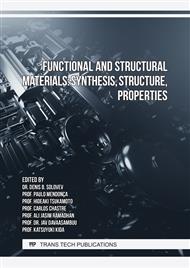[1]
V.P. Haridasan, A. Velayudham, R. Krishnamurthy, Response surface modeling and parameter optimization of detonation spraying with enhanced coating performance, Materials Today: Proceedings. Volume 46, Part 9 (2021) 3474-3481.
DOI: 10.1016/j.matpr.2020.11.867
Google Scholar
[2]
V. Yu. Ulianitsky, A.A. Shtertser, I.S. Batraev, D.K. Rybin, Fabrication of layered ceramic-metal composites by detonation spraying Ceramics International. Volume 46 (2020) 27903-27908.
DOI: 10.1016/j.ceramint.2020.07.225
Google Scholar
[3]
V. Yu. Ulianitsky, I. S. Batraev, A. A. Shtertser, D. V. Dudina, N. V. Bulina, I. Smurov, Detonation spraying behaviour of refractory metals: Case studies for Mo and Ta-based powders, Advanced Powder Technology. Volume 29, Issue 8 (2018) 1859-1864.
DOI: 10.1016/j.apt.2018.04.023
Google Scholar
[4]
D. K. Rybin, I. S. Batraev, D. V. Dudina, A. V. Ukhina, V. Yu. Ulianitsky, Deposition of tungsten coatings by detonation spraying Surface and Coatings Technology. Volume 409 (2021) 126943.
DOI: 10.1016/j.surfcoat.2021.126943
Google Scholar
[5]
A.A. Shtertsera, D.K. Rybin, V.Yu. Ulianitsky, W. Park, M. Datekyu, T. Wada, H. Kato, Characterization of nanoscale detonation carbon produced in a pulse gas-detonation device, Diamond and Related Materials. Volume 101 (2020) 107553.
DOI: 10.1016/j.diamond.2019.107553
Google Scholar
[6]
Sh. Cui, H. Zhai, W. Li, X. Fan, X. Li, W. Ning, Dangsheng Xiong Microstructure and tribological properties of Fe-based amorphous coating prepared by detonation spray, Journal of Non-Crystalline Solids. Volume 556 (2021) 120564.
DOI: 10.1016/j.jnoncrysol.2020.120564
Google Scholar
[7]
V. Yu. Ulianitsky, D. K. Rybin, A. V. Ukhina, B. B. Bokhonov, D. V. Dudina, M. N. Samodurova, E. A. Trofimov, Structure and composition of Fe-Co-Ni and Fe-Co-Ni-Cu coatings obtained by detonation spraying of powder mixtures. Materials Letters. Volume 290 (2021) 129498.
DOI: 10.1016/j.matlet.2021.129498
Google Scholar
[8]
V. Yu. Ulianitsky, D. V. Dudina, I. S. Batraev, A. I. Kovalenko, N. V. Bulina. B. B. Bokhonov, Detonation spraying of titanium and formation of coatings with spraying atmosphere-dependent phase composition, Surface and Coatings Technology. Volume 261 (2015) 174-180.
DOI: 10.1016/j.surfcoat.2014.11.038
Google Scholar
[9]
D. V. Dudina, M. A. Korchagin, S. B. Zlobin, V. Yu. Ulianitsky, O. I. Lomovsky, N.V. Bulina, I. A. Bataev, V. A. Bataev, Compositional variations in the coatings formed by detonation spraying of Ti3Al at different O2/C2H2 ratios, Intermetallics. Volume 29 (2012) 140-146.
DOI: 10.1016/j.intermet.2012.05.010
Google Scholar
[10]
V.P. Haridasan, A. Velayudham, R. Krishnamurthy, Response surface modeling and parameter optimization of detonation spraying with enhanced coating performance, Materials Today: Proceedings. Volume 46, Part 9 (2021) 3474-3481.
DOI: 10.1016/j.matpr.2020.11.867
Google Scholar
[11]
I. S. Batraev, V. Yu. Ulianitsky, D. V. Dudina, Detonation spraying of copper: theoretical analysis and experimental studies, Materials Today: Proceedings. Volume 46, Part 9 (2021) 3474-3481.
DOI: 10.1016/j.matpr.2017.09.006
Google Scholar
[12]
V. Ulianitsky, I. Batraev, D. Dudina, I. Smurov, Enhancing the properties of WC/Co detonation coatings using two-component fuels, Surface and Coatings Technology. Volume 318 (2017) 244-249.
DOI: 10.1016/j.surfcoat.2016.08.008
Google Scholar
[13]
D. V. Dudina, G. A. Pribytkov, M. G. Krinitcyn, M. A. Korchagin, N. V. Bulina, B. B. Bokhonov, I. S. Batraev, D. K. Rybin, V. Yu. Ulianitsky, Detonation spraying behavior of TiCx–Ti powders and the role of reactive processes in the coating formation, Ceramics International. Volume 42, Issue 1, Part A (2016) 690-696.
DOI: 10.1016/j.ceramint.2015.08.166
Google Scholar
[14]
D. V. Dudina, I. S. Batraev, V. Yu. Ulianitsky, M. A. Korchagin, Possibilities of the Computer-Controlled Detonation Spraying method: A chemistry viewpoint, Ceramics International. Volume 40, Issue 2 (2014) 3253-3260.
DOI: 10.1016/j.ceramint.2013.09.111
Google Scholar
[15]
D. V. Dudina, S. B. Zlobin, N. V. Bulina, A. L. Bychkov, V. N. Korolyuk, V. Yu. Ulianitsky, O. I. Lomovsky, Detonation spraying of TiO2–2.5 vol.% Ag powders in a reducing atmosphere, Journal of the European Ceramic Society. Volume 32, Issue 4 (2012) 815-821.
DOI: 10.1016/j.jeurceramsoc.2011.10.022
Google Scholar
[16]
A. Shtertser, C. Muders, S. Veselov, S. Zlobin, V. Ulianitsky, X. Jiang, V. Bataev, Computer controlled detonation spraying of WC/Co coatings containing MoS2 solid lubricant, Surface and Coatings Technology. Volume 206, Issue 23 (2012) 4763-4770.
DOI: 10.1016/j.surfcoat.2012.03.043
Google Scholar
[17]
V. Yu. Ulianitsky, D. V. Dudina, I. S. Batraev, D. K. Rybin, N. V. Bulina, A. V. Ukhina, B. B. Bokhonov, The influence of the in-situ formed and added carbon on the formation of metastable Ni-based phases during detonation spraying, Materials Letters. Volume 181 (2016) 127-131.
DOI: 10.1016/j.matlet.2016.06.022
Google Scholar
[18]
W.-B. Liao, Zh.-X. Wu, W. Lu, M. He, T. Wang, Z. Guo, J. Huang, Microstructures and mechanical properties of CoCrFeNiMn high-entropy alloy coatings by detonation spraying, Intermetallics. Volume 132 (2021) 107138.
DOI: 10.1016/j.intermet.2021.107138
Google Scholar
[19]
A. A. Shtertser, I. S. Batraev, V. Yu. Ulianitsky, I. D. Kuchumova, N. V. Bulina, A. V. Ukhina, B. B. Bokhonov, D. V. Dudina, Ph. V. Trinh, D. D. Phuong, Detonation spraying of Ti-Cu mixtures in different atmospheres: Carbon, nitrogen and oxygen uptake by the powders. Surfaces and Interfaces. Volume 21 (2020) 100676.
DOI: 10.1016/j.surfin.2020.100676
Google Scholar
[20]
M.V. Nenashev, D.A. Demoretsky, S.Y. Ganigin, I.V. Nechaev, I.A. Kuznetsov, A.A. Novikov, V.L. Simogin, A.Y. Murzin, A.G. Popov, A.T. Nurmukhametov, N.S. Aldebenev, M.S. Grechukhina, I.R. Toneev, RU Patent 2,744,805 (2021).
Google Scholar
[21]
I. Nechaeva, A. Nechaev, Method of Assessing the Sensitivity of the Dust-Air Mixture to Thermal Effects Caused by Electric Discharge / Proceedings, 21st International Conference "Complex Systems: Control and Modeling Problems, CSCMP. 553-557 (2019) 8976612.
DOI: 10.1109/cscmp45713.2019.8976612
Google Scholar
[22]
D. V. Lakshmi, P. S. Babu, L. R. Krishna, R. Vijay, D. S. Rao, G. Padmanabham, Corrosion and erosion behavior of iron aluminide (FeAl(Cr)) coating deposited by detonation spray technique Advanced Powder Technology. Volume 32, Issue 7 (2021) 2192-2201.
DOI: 10.1016/j.apt.2021.04.032
Google Scholar


